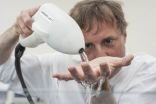The influence of citizen science grows despite some resistance
2015-09-16
(Press-News.org) Citizen science is taking off and could make a difference at regional and national regulatory levels. But not everyone thinks that's a good idea. The cover story of Chemical & Engineering News (C&EN), the weekly newsmagazine of the American Chemical Society, delves into the progress of the budding movement, as well as the pushback.
Steven K. Gibb, senior editor at C&EN, reports that in some states, regulators actively encourage and support local residents' participation in environmental monitoring. For example, Maryland's Department of the Environment and Department of Natural Resources welcome the data collected by local volunteer groups. One of these nonprofits has been collecting water quality data for 10 years from 21 locations on a tributary of the Chesapeake Bay. The state only has one monitoring location in the same area. In 2014, citizen scientists' data helped Maryland put together its required Clean Water Act report, which informs future regulations.
On the other hand, some states are weary of such efforts. Policymakers in Ohio passed a law in 2003 mandating that state agencies only use water quality data that's been gathered by a qualified collector. Idaho, Utah and Wyoming prohibit citizen scientists from collecting environmental data near agricultural sites. But at the national and international levels, the movement is becoming more accepted. Federal officials at the U.S. Environmental Protection Agency are friendly to the idea. And national groups advancing the trend have sprung up in the U.S., Europe and Australia.
INFORMATION:
The American Chemical Society is a nonprofit organization chartered by the U.S. Congress. With more than 158,000 members, ACS is the world's largest scientific society and a global leader in providing access to chemistry-related research through its multiple databases, peer-reviewed journals and scientific conferences. Its main offices are in Washington, D.C., and Columbus, Ohio.
To automatically receive news releases from the American Chemical Society, contact newsroom@acs.org.
Follow us: Twitter
Facebook
ELSE PRESS RELEASES FROM THIS DATE:
2015-09-16
Fossils tell amazing stories and inspire them, too -- just think of this summer's "Jurassic World" blockbuster. But because some of the processes that preserve fossils are not well understood, there's still more information that they could reveal. Now scientists report in ACS' journal Analytical Chemistry a new way to probe fossils to find out how these ancient remains formed in greater detail than before.
When most organisms die, they biodegrade and leave little behind. But if they get trapped in sediments that harbor few bacteria and loads of dissolved minerals, they ...
2015-09-16
Coughing. A sore throat. Maybe a pain in your chest as you take a deep breath.
These are all common symptoms for many city-living Australians when smog levels are high. And while it is well understood that smog can cause such problems, new research has for the first time given us a glimpse as to what might be happening at the molecular level.
The University of Melbourne's Professor Richard O'Hair, from the School of Chemistry's Bio21 Institute, in collaboration with Professor Stephen Blanksby (from the Queensland University of Technology and formerly the University ...
2015-09-16
Researchers from the University of Southampton have demonstrated how a pioneering ultrasonic device can significantly improve the cleaning of medical instruments and reduce contamination and risk of infection.
StarStream, invented and patented by the University of Southampton and in commercial production by Ultrawave Ltd., makes water more efficient for cleaning by creating tiny bubbles which automatically scrub surfaces. The device supplies a gentle stream of water through a nozzle that generates ultrasound and bubbles, which dramatically improve the cleaning power of ...
2015-09-16
This news release is available in German.
Platinum is a great catalyst and can be used for many different applications. It's expensive stuff though, so tiny platinum nanoparticles sitting on cheap metal oxide materials are used to convert harmful carbon monoxide into carbon dioxide. Using scanning tunnelling microscopes, scientists at TU Vienna have now been able to image the catalytic behaviour of platinum sitting on iron-oxide, which allowed them to explain the process on an atomic scale. Surprisingly, the chemical reactions do not take place on the platinum ...
2015-09-16
Researchers at the University of Birmingham have shown how the development of coated silica nanoparticles could be used in restorative treatment of sensitive teeth and preventing the onset of tooth decay.
The study, published in the Journal of Dentistry, shows how sub-micron silica particles can be prepared to deliver important compounds into damaged teeth through tubules in the dentine.
The tiny particles can be bound to compounds ranging from calcium tooth building materials to antimicrobials that prevent infection.
Professor Damien Walmsley, from the School of ...
2015-09-16
This news release is available in German.
Topical research experiments are often too expensive or too complex to be rebuilt and incorporated in teaching. How can one, nevertheless, make modern science accessible to the public? This challenge was tackled in the research group Quantum Nanophysics led by Markus Arndt at the University of Vienna. For the first time, two research laboratories were created as complete, photorealistic computer simulations allowing university and high-school students as well as the general public to virtually access unique instruments. ...
2015-09-16
EUGENE, Ore. -- (Sept. 16, 2015) -- New research at the University of Oregon finds that an organization's logo on a food product can trigger quick perceptions by consumers about an item's healthiness and influence their decision-making.
That perception also may be seen as an endorsement that may not exist, say study co-authors Elizabeth Minton of the University of Wyoming and T. Bettina Cornwell, the Edwin E. & June Woldt Cone Professor of Marketing in the Lundquist College of Business at the UO.
The research, led by Minton as part of her doctoral dissertation at the ...
2015-09-16
TORONTO [11 September 2015] A team of astronomers has given us our best view yet of an exoplanet moving in its orbit around a distant star. A series of images captured between November 2013 to April 2015 shows the exoplanet β Pic b as it moves through 1 ½ years of its 22-year orbital period.
First discovered in 2008, β Pic b is a gas giant planet ten to twelve times the mass of Jupiter, with an orbit roughly the diameter of Saturn's. It is part of the dynamic and complex system of the star β Pictoris which lies over 60 light-years from Earth. The ...
2015-09-16
The use of antidepressants during pregnancy has no long term neurodevelopmental or behavioural effects on the child, however they may be associated with an increased risk of postpartum haemorrhage, suggests the findings from three studies published in BJOG: An International Journal of Obstetrics and Gynaecology (BJOG).
Depression and anxiety are the most common mental health problems during pregnancy, with around 12% of women in the UK experiencing depression at some point during pregnancy and the postnatal period. The use of antidepressants such as selective serotonin ...
2015-09-16
Stanford University School of Medicine researchers and their colleagues are calling for an urgent re-evaluation of global guidelines for the treatment of parasitic-worm diseases in light of a new study showing that large-scale treatment programs are highly cost-effective.
Parasitic-worm diseases afflict some 1.5 billion people in the developing world, causing gastrointestinal problems, anemia, wasting, and cognitive and growth deficits in children, and in some cases, liver, bladder and intestinal problems that can be fatal. About 150,000 people die of complications from ...
LAST 30 PRESS RELEASES:
[Press-News.org] The influence of citizen science grows despite some resistance



